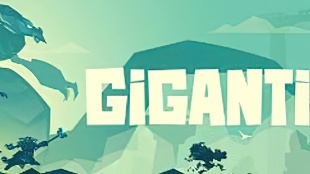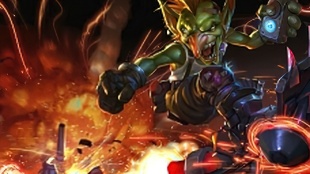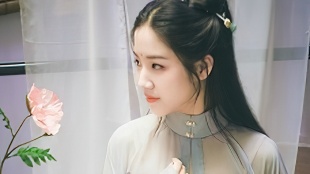您需要 登录 才可以下载或查看,没有账号?注册

x
Introduction
My name is Shada Harb. I am a 3D Artist from Beirut, Lebanon. I received my Bachelor of Arts in 3D Game Art & Animation from SAE Institute Berlin in 2021. Upon graduating, I left my work position at SAE Institute as Game Art Department Assistant and moved to Brooklyn, New York in August 2021.
Hailing from Beirut, where an economic crisis and corruption are ravaging the country, I have taken an unconventional trajectory in my career and have yet to officially work in the 3D art field. Instead, I have decided to take some time to explore a new life and find myself in my craft while enjoying various jobs such as bartending and now working as an optician at a French eye-wear brand, Anne & Valentin.
介绍
我的名字是Shada Harb。我是来自黎巴嫩贝鲁特的3D艺术家。我于2021年从柏林SAE学院获得了3D游戏艺术与动画学士学位。毕业后,我离开了SAE学院的游戏艺术部门助理,并于2021年8月搬到了纽约布鲁克林。
我来自贝鲁特,那里的经济危机和腐败正在蹂躏这个国家,在我的职业生涯中走上了一条非常规的轨迹,还没有正式在3D艺术领域工作。相反,我决定花一些时间探索新的生活,发现自己在享受各种工作的同时,享受各种工作,如调酒,现在在法国眼镜品牌Anne & Valentin担任眼镜商。

The 2Q84:LoneStar Project
The animation was created as the final project for my bachelor's degree. The core aim of the project was to hone previous skills attained, such as Environment Art and Clothing Creation, while simultaneously adapting to and learning skills required for the creation of a 3D animation – the latter being an art form I had not explored.
The animation concept is of a non-binary character stuck in a cycle of repetition. It touches on the allure of playing a video game and how that can be a form of escapism while also twisting that concept into a matter that is dark and absurd. It is both a relatable and terrifying concept, one that many “gamers” have potentially experienced: the relief that comes from the escape of playing an immersive game or exploring the realms of virtual reality, but it could also pose a threat. The decision to have a non-binary character was rather natural as gender and sex do not impact the situation posed in the concept.
2Q84:孤星计划
动画是我学士学位的最终项目。该项目的核心目标是磨练以前获得的技能,如环境艺术和服装创作,同时适应和学习创作3D动画所需的技能 - 后者是一种我没有探索过的艺术形式。
动画概念是一个非二进制角色陷入重复的循环。它触及了玩视频游戏的诱惑力,以及它如何成为一种逃避现实的形式,同时也将这个概念扭曲成一个黑暗和荒谬的事情。这是一个既相关又可怕的概念,许多“游戏玩家”可能已经体验过这个概念:玩沉浸式游戏或探索虚拟现实领域所带来的解脱,但它也可能构成威胁。具有非二元字符的决定是相当自然的,因为性别和性别不会影响概念中出现的情况。
The time setting of the scene is as if the 1980s were occurring in the future and in a parallel world. Most elements are from the 80s, while the core machine elements are futuristic, serving as a contrast. I was definitely inspired by the aesthetics of the 80s and the technological possibilities that a futuristic/cyberpunk world could bring.
Without a doubt, most aspects of the story itself were inspired by my own attempts to explore the state of mind I was in during that time and the struggle I was experiencing, partially from not knowing how to be in touch with the reality of the state of things: being separated from home and family while my country was destroyed without my being able to say goodbye.
场景的时间设定就好像1980年代发生在未来和平行世界中一样。大多数元素来自80年代,而核心机器元素是未来主义的,作为对比。我绝对受到80年代美学的启发,以及未来主义/赛博朋克世界可能带来的技术可能性。
毫無疑問,故事本身的大部分方面都是受到我自己嘗試探索我在那段時間的心態和我經歷的鬥爭的啟發,部分原因是不知道如何接觸到事物狀況的現實:與家和家庭分開,而我的國家被摧毀而無法說再見。

Initially, I planned to be responsible for the entire animation creation from scratch, not including the audio and sound effects of course. However, seeing as I had limited time for completion and a massive load of tasks including ones I had never attempted before, I enlisted the help of Anastasiia Holumbovska – SAE Institute Berlin’s head instructor of Game Art at that time – as she had experience with 2D Art, rigging and animating, motion capture and Maya.
I was responsible for the overall creative/art direction of the animation, the storyboard and storytelling, the environment art and props, character design, clothing creation, camera setup, rendering, credits scene, and editing.
The tools I used throughout the project were 3ds Max, Maya, Marmoset Toolbag, Substance 3D Painter and Designer, Marvelous Designer, ZBrush, Premiere Pro, and After Effects.
最初,我计划从头开始负责整个动画创作,当然不包括音频和声音效果。然而,鉴于我完成的时间有限,而且任务繁重,包括我以前从未尝试过的任务,我得到了当时柏林SAE学院游戏艺术首席讲师Anastasiia Holumbovska的帮助,因为她有2D艺术,索具和动画,动作捕捉和玛雅的经验。
我负责动画的整体创意/艺术指导,故事板和讲故事,环境艺术和道具,角色设计,服装创作,摄像机设置,渲染,演职员表场景和编辑。
我在整个项目中使用的工具是3ds Max,Maya,Marmoset Toolbag,Substance 3D Painter and Designer,Marvelous Designer,ZBrush,Premiere Pro和After Effects。
Environment & Assets
All main assets were created manually. The room started as a blockout scene in 3ds Max before being transferred to Maya for scene implementation. As a 3D modeler, I am most efficient in 3ds Max. Every main asset was created separately and taken through the entire prop art pipeline individually in order to ensure that they were created to perfection.
I prioritized quality over quantity as I could have modeled an infinite amount of assets to add to the scene without insurance that there would be enough time to texture every one of them. Some minor assets, such as trash elements, were downloaded for free as ready-made assets. Others, such as the trash bags and the table lamp, were created by fellow 3D Artists at SAE Institute Berlin.
My primary “hero assets” consisted of the room structure itself, the television, the game console, the radio, the machines, the headset, and the character's clothing. Each of these was created entirely from scratch down to the details, including the “LoneStar” logos.
环境与资产
所有主要资产都是手动创建的。该房间最初是 3ds Max 中的一个遮挡场景,然后转移到 Maya 进行场景实现。作为一名 3D 建模师,我在 3ds Max 中效率最高。每个主要资产都是单独创建的,并分别通过整个道具艺术管道进行,以确保它们被创建得完美无缺。
我把质量放在数量上,因为我可以建模无限数量的资产以添加到场景中,而无需确保有足够的时间来纹理化每个资产。一些次要资源,如垃圾元素,作为现成的资源免费下载。其他的,如垃圾袋和台灯,是由柏林SAE研究所的3D艺术家创作的。
我的主要“英雄资产”包括房间结构本身,电视,游戏机,收音机,机器,耳机和角色的衣服。这些都是完全从头开始创建的细节,包括“LoneStar”徽标。
TV 3D Model – 3ds Max:
电视 3D 模型 – 3ds Max:
(NES) Console 3D Model – 3ds Max:
(网)控制台 3D 模型 – 3ds Max:
(NES) Controller 3D Model – 3ds Max:
(网)控制器 3D 模型 – 3ds Max:
Machine 3D Model – 3ds Max:
机器 3D 模型 – 3ds Max:
Headset 3D Model – 3Ds Max:
耳机 3D 模型 – 3Ds Max:
I began with low poly modeling in 3ds Max followed by a high poly model. These were then baked in Marmoset Toolbag and taken to Substance 3D Painter for texturing. Some materials – such as the painted walls or specific logos - were created in Substance 3D Designer and then imported into Painter.
我从 3ds Max 中的低多边形建模开始,然后是高多边形模型。然后将这些放在狨猴工具袋中烘烤,并带到Substance 3D Painter进行纹理处理。一些材料( 例如彩绘的墙壁或特定徽标) 是在 Substance 3D Designer 中创建的,然后导入到 Painter 中。
TV Texturing Render Test – Substance 3D Painter:
电视纹理渲染测试 - 物质3D画家:
TV Texture Maps:
电视纹理贴图:
(NES) Console Texturing Render Test – Marmoset Toolbag:
(网)控制台纹理渲染测试 – 狨猴工具包:
Console Texture Maps:
控制台纹理贴图:
Radio Texturing Render Test – Substance 3D Painter:
无线电纹理渲染测试 – 物质 3D 画家:
Headset Texturing Render Test – Substance 3D Painter:
耳机纹理渲染测试 – 物质 3D 画家:
Machine Texturing Render Test – Substance 3D Painter:
机器纹理渲染测试 – 物质 3D 画家:
Characters, Clothes & Animations
The character was created from a base mesh that Anastasiia had used in a prior project. It was then re-sculpted/adapted by Anastasiia and detailed according to the image I had of what the character would look like. Luckily for us, that mesh already had a retopologized version and we could play with the subdivision levels in ZBrush easily.
角色、服装和动画
这个角色是由阿纳斯塔西娅在之前的项目中使用的基础网格体创建的。然后由Anastasiia重新雕刻/改编,并根据我对角色外观的图像进行详细说明。对我们来说幸运的是,该网格已经有了一个重新拓扑化的版本,我们可以很容易地在ZBrush中玩细分关卡。
The jacket and shorts were created entirely in Marvelous Designer. It’s absolutely one of my favorite programs and things to do. It was definitely complex as I had a very detailed design in mind for that kind of jacket, and trying to have all these layers for the cuffs and zippers while also maintaining the desirable folds was challenging.
After sewing all my patterns and being satisfied with the overall structure, I went over the clothes in ZBrush and detailed them further. Some folds were refined and exaggerated and others were added. The zipper and stitches were also done in ZBrush with the help of ready-made brushes. The socks were then sculpted in ZBrush by extracting a mesh from the feet and then molding and refining that to have the look I was going for. Afterwards, decimated models of the clothes were imported into Maya so I could retopologize them manually.
夹克和短裤完全是用Marvelous Designer制作的。这绝对是我最喜欢的程序和事情之一。这绝对是复杂的,因为我为这种夹克设计了非常详细的设计,并且试图为袖口和拉链提供所有这些层,同时保持理想的褶皱是具有挑战性的。
在缝制完所有图案并对整体结构感到满意之后,我仔细检查了ZBrush中的衣服并进一步详细说明了它们。一些褶皱被改进和夸大,另一些则被添加。拉链和缝线也是在现成的刷子的帮助下用ZBrush完成的。然后用ZBrush雕刻袜子,从脚上取下网眼,然后成型和精炼,以获得我想要的外观。之后,被大量删除的衣服模型被导入到Maya中,这样我就可以手动重新拓扑化它们。
Clothing Creation – Marvelous Designer:
服装创作 – 奇妙的设计师:
Socks 3D Sculpt – ZBrush:
袜子3D雕刻 - ZBrush:
Socks Retopology – Maya:
袜子重新拓扑 – 玛雅:
Character/Clothes Render Test – Maya:
角色/衣服渲染测试 – 玛雅:
Character/Clothes Render Test – Maya:
角色/衣服渲染测试 – 玛雅:
Character/Clothes Texturing Render Test – Maya
角色/服装纹理渲染测试 – 玛雅
When it came to the character animations, it was definitely improvised. The original plan was to do motion capture. We had a mo-cap suit at SAE that we planned to utilize. We captured the mo-cap with me being the actor as I had a particular idea for the movements of the character. Unfortunately, we realized afterwards that the suit was faulty and every recording was basically unusable. That is what led to the need for rigging and animating the character from scratch, and thankfully, Anastasiia had some prior experience with that.
说到角色动画,绝对是即兴创作的。最初的计划是做动作捕捉。我们在SAE有一套动作帽套装,我们计划使用它。我们以我作为演员的身份捕捉了动作帽,因为我对角色的动作有一个特别的想法。不幸的是,我们后来意识到西装有问题,每个录音基本上都无法使用。这就是导致需要从头开始操纵和动画化角色的原因,值得庆幸的是,阿纳斯塔西娅以前有过这方面的一些经验。
We ended up filming my movements with the song that was used in the video, Sunshower Vox, so she had a very specific blueprint for the animation. These little struggles lead to chunks of the animation being not quite polished to my taste, but that was a big opportunity on learning how to let go and improvise instead.
我们最终用视频中使用的歌曲Sunshower Vox拍摄了我的动作,所以她有一个非常具体的动画蓝图。这些小小的挣扎导致动画的大部分内容没有完全符合我的口味,但这是学习如何放手和即兴创作的一大机会。
The TV screen texture animations were fairly simple as I had most of the content downloaded from different sources. The gameplay video was extracted from the game 198x by Hi-Bit Studios. The game over screen effect was created using After Effects. Then, the entire sequence was exported as PNGs to be loaded onto the TV screen material in Maya as an image sequence. Other minor animations within the scene, such as the radio, were also easy due to Maya’s intuitive keyframe method. The credits scene was created entirely in Marmoset Toolbag with the help of its effortless keyframing methods for controls of asset visibility and emissive map intensity.
电视屏幕纹理动画相当简单,因为我的大部分内容都是从不同的来源下载的。游戏视频由Hi-Bit Studios从游戏198x中提取。游戏过屏效果是使用 After Effects 创建的。然后,将整个序列导出为 PNG,以作为图像序列加载到 Maya 中的电视屏幕素材中。场景中的其他次要动画,如收音机,由于Maya直观的关键帧方法也很容易。片尾字幕场景完全是在Marmoset Toolbag中创建的,借助其轻松的按帧方法控制资产可见性和发射地图强度。
TV Screen Animation Setup – Maya:
电视屏幕动画设置 – 玛雅:
Radio Key Frame Animation – Maya:
无线电关键帧动画 – 玛雅:
Credits Scene Animation – Marmoset Toolbag:
学分场景动画 - 狨猴工具袋:
The Camera Work
Roughly half of the camera shots were determined early on during the pre-production phase. I had a storyboard blueprint made that I could follow throughout the production. Since 2D art is not my expertise, I have never had the ease of drawing out the images in my head. Instead, I created the 3D blockout of the room in 3ds Max with a dummy in place of the character.
相机工作原理
大约一半的摄像机镜头是在前期制作阶段早期确定的。我制作了一个故事板蓝图,我可以在整个制作过程中遵循。由于2D艺术不是我的专长,我从来没有那么容易地在脑海中绘制出图像。相反,我在 3ds Max 中创建了房间的 3D 遮挡,并用假人代替了角色。
I placed cameras throughout the scene and took some shots of the scene, which I then took to Photoshop and drew over in a very scrappy manner. Many of these shots and angles ended up being used when actually filming and rendering the animation, such as the shots of the radio and the tapping of buttons on the controller.
我在整个场景中放置了相机,并拍摄了一些场景的照片,然后我将其带到Photoshop上并以非常随意的方式绘制。其中许多镜头和角度最终在实际拍摄和渲染动画时使用,例如收音机的镜头和控制器上的按钮点击。
3D Blockout – 3ds Max:
3D 封锁 – 最大 3ds:
Storyboard Part 1 – Photoshop:
故事板第1部分 - Photoshop:
Of course, after the scene was entirely implemented in Maya, I had newfound creative freedom to go off the blueprint and experiment with different shots. I did my research on different shot types and how they are used to convey a story. I knew I needed some establishing shots where one could try to understand the setting of the scene and the state of the room (why is there a dead plant? How much time has passed with this character stuck in their headset?)
当然,在Maya中完全实现场景后,我有了新的创作自由,可以脱离蓝图并尝试不同的镜头。我对不同的镜头类型以及它们如何用于传达故事进行了研究。我知道我需要一些建立镜头,人们可以尝试理解场景的设置和房间的状态(为什么会有一棵死植物?这个角色卡在他们的耳机里已经过去了多少时间?
I considered how I could show that there is an absurd loop happening here without being forceful about it – a loop that was definitely inspired by Samuel Beckett’s “Play”. That is how I came to create those simple beginning and end shots of the radio and the loading screen. The Dutch angle was also used on the character upon witnessing their twitching eye after being electrocuted to emphasize the strange and disorienting absurdity of that moment.
我考虑过如何证明这里发生了一个荒谬的循环,而没有强行说明它 - 这个循环绝对受到塞缪尔贝克特的“游戏”的启发。这就是我如何创建收音机和加载屏幕的简单开始和结束镜头。在目睹角色被电击后抽搐的眼睛时,也使用了荷兰角,以强调那一刻的奇怪和迷失方向的荒谬。
The entirety of the camera work was both exciting and challenging as I knew I had a limited set of shots I could do and thus needed to convey the story as efficiently as possible to avoid having an insane render-time. A lot of shots had to be re-done after rendering them because I wasn’t content with the overall look or purpose of the shot, so there was definitely some back-and-forth tweaking all around. But at some point, I had to call it and be content with what I had in order to give the much-needed time for all the camera shots to render in high-quality in Arnold, Maya.
整个摄影工作既令人兴奋又具有挑战性,因为我知道我能做的镜头有限,因此需要尽可能有效地传达故事,以避免疯狂的渲染时间。很多镜头在渲染后必须重新完成,因为我对镜头的整体外观或目的不满意,所以肯定有一些来回调整。但在某些时候,我不得不打电话给它,并满足于我所拥有的,以便为所有摄像机镜头提供急需的时间,以便在玛雅的阿诺德以高质量渲染。
Conclusion
Without including the pre-production phase, the project took about 6 months to finish: from September 2020 to March 2021. This was done as I was writing my BA thesis and working at SAE Institute. The pre-production phase alone took about a month of me doing my research on methods and techniques as well as gathering a large number of references for every aspect of the project. And to be honest, the project needed even more time, but I had to make do with the deadline I had.
结论
在没有包括预生产阶段的情况下,该项目花了大约6个月的时间才完成:从2020年9月到2021年3月。这是在我写我的学士学位论文并在SAE学院工作时完成的。仅在前期制作阶段,我就花了大约一个月的时间进行方法和技术研究,并为项目的各个方面收集了大量参考资料。说实话,这个项目需要更多的时间,但我必须遵守我的最后期限。
Apart from the big inconvenience of having unusable motion capture data, one of the challenges was having an extremely heavy scene to work with on mediocre computers/laptops. For example, I wanted the wires of the machine and the headset to have a very fluid movement that followed the character naturally. We attempted to animate the wires with nCloth in Maya, but Maya would consistently crash or slow down whenever they would be tweaked. So there were some chunks of the wire animation that had to be done manually as well.
除了拥有不可用的动作捕捉数据的巨大不便之外,其中一个挑战是在平庸的计算机/笔记本电脑上使用极其繁重的场景。例如,我希望机器和耳机的电线具有非常流畅的运动,自然地跟随角色。我们试图在Maya中使用nCloth对电线进行动画处理,但是每当它们被调整时,Maya都会不断崩溃或减速。因此,线材动画的一些部分也必须手动完成。
Wires nCloth – Maya:
电线 n 布 – 玛雅:
Setting up the lighting was also slightly challenging. Personally, I found it not as intuitive as setting up lights in Unreal Engine or Marmoset Toolbag. The two main sources of light were to be from the window and the TV. Originally, I desired a pink light from the TV and a cold blue in the atmosphere. However, while attempting to execute this, I realized it was not working as I had imagined. It required a lot of refining and trial in order to get the results I could work with.
设置照明也略有挑战性。就个人而言,我发现它不像在虚幻引擎或Marmoset Toolbag中设置灯光那样直观。两个主要的光源是来自窗户和电视。最初,我想要电视上的粉红色光线和大气中的冷蓝色。但是,在尝试执行此命令时,我意识到它并不像我想象的那样有效。它需要大量的改进和试验才能获得我可以处理的结果。
The rendering phase was one of the most intense. I had around twenty-six camera shots with each ranging around 200 frames, give or take, and one frame alone took roughly thirty minutes to render. Thus I set up a render farm on the computers at SAE. However, this did not go as smoothly as I hoped. For some reason, some of the computers would shut down mid-rendering and I would have to set them up again. Some renders had inexplainable errors such as rendering only portions of a frame or the TV screen suddenly turning white. Therefore the rendering phase took extremely longer than anticipated and caused its own need for improvisation.
渲染阶段是最激烈的阶段之一。我有大约26张相机照片,每张照片的范围大约200帧,给出或拍摄,仅一帧就花了大约三十分钟来渲染。因此,我在 SAE 的计算机上设置了一个渲染场。然而,这并没有像我希望的那样顺利。由于某种原因,一些计算机会在渲染过程中关闭,我不得不再次设置它们。一些渲染存在无法解释的错误,例如仅渲染帧的一部分或电视屏幕突然变白。因此,渲染阶段花费的时间比预期的要长得多,并导致其自身对即兴创作的需求。
Render Error – Arnold Maya:
渲染错误 – 阿诺德·玛雅:
Personally, the challenges experienced while creating the animation almost made me feel one with the character: in constant pursuit of something which, with every mistake, causes immense deterioration. This deterioration refers to the project itself: all throughout the production, every misstep or error encountered made me feel as if the vision I had in my mind would not be fully accomplished. However, given that I prefer imagining an ambitious project and do my best at it, I learned how to let go and accept that my vision is correlated with the best I can give.
就个人而言,在创作动画时所经历的挑战几乎让我感觉到与角色融为一体:不断追求每一个错误都会导致巨大恶化的东西。这种恶化指的是项目本身:在整个制作过程中,遇到的每一个失误或错误都让我觉得我脑海中的愿景不会完全实现。然而,鉴于我更喜欢想象一个雄心勃勃的项目并尽我所能,我学会了如何放手并接受我的愿景与我所能给予的最好的东西相关。
Overall, it was an intense learning experience. Storytelling has always been a passion of mine, regardless of the art medium (a big joy in my life has been my previous experiences of acting in theatre.) Storytelling through cameras was a first and it was definitely illuminating as it allowed me to explore hidden areas within the craft. Even better, I experienced the thrilling taste of directing a personal production while working with other incredible artists – such as Rafael Nicolau who created all the sound effects – which was by far the most rewarding experience.
总的来说,这是一次紧张的学习经历。讲故事一直是我的激情所在,无论艺术媒介如何(我生命中最大的乐趣是我以前在剧院表演的经历。通过相机讲故事是第一次,它绝对具有启发性,因为它允许我探索飞船内的隐藏区域。更好的是,我体验到了指导个人作品的惊险滋味,同时与其他令人难以置信的艺术家合作 - 例如创造了所有音效的拉斐尔·尼古拉(Rafael Nicolau) - 这是迄今为止最有价值的体验。
The project also determined the natural incline I have for creating 3D prop art while reaffirming my desire to create profound and innovative video games and tell stories that do not shy away from the deepest (and sometimes darkest) parts of ourselves and of the world we live in.
该项目还确定了我创作3D道具艺术的自然倾向,同时重申了我渴望创建深刻和创新的视频游戏,并讲述不回避我们自己和我们生活的世界最深处(有时是最黑暗)部分的故事。
To me, ultimately, 2Q84:LoneStar was about diving into the internal world of the character and posing such questions: what if the subjective survival method for someone is to escape from reality? What if the reward system within that escape includes punishment? – a nod to the judgment we impose on ourselves when we attempt self-care in any shape or form. To what extent do we have free will? What if we had no choice in being stuck? What would that make of us? And the LoneStar machine was the catalyst for the questions.
对我来说,最终,2Q84:孤星是关于潜入角色的里面世界并提出这样的问题:如果某人的主观生存方法是逃避现实呢?如果逃脱中的奖励系统包括惩罚呢?– 当我们试图以任何形式或形式进行自我护理时,我们强加给自己的判断的致敬。我们在多大程度上有自由意志?如果我们别无选择地陷入困境呢?这会对我们产生什么影响?而LoneStar机器是这些问题的催化剂。
|







 评分
评分






